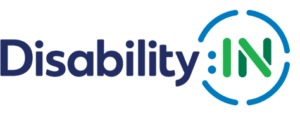
Disability:IN and our Accessibility Leadership Committee recognize that digital accessibility is crucial to the success of every diversity and inclusion initiative. The sudden switch to remote work due to the global coronavirus pandemic has highlighted the importance of digital accessibility at work – wherever that work takes place.
Drawing on the collective expertise of our corporate partners, this section of Disability:IN’s COVID-19 Response Series lists action items to help organizations ensure that employees with disabilities are included in all aspects of remote work during this crisis and always.
Five Tips to make Your Virtual Meetings More Inclusive from EY
Teaming virtually offers a terrific opportunity to advance our inclusive culture and belonging by modeling some simple practices. Start every call by reviewing the following protocols:
- Enable captions in Teams or the Platform you are Using. For Teams, please follow these Microsoft instructions: Enabling Captioning in Microsoft Teams. Captioning will appear across the bottom of the screen.
- Identify yourself each time you speak.
- Avoid acronyms or use complete words the first time. Not all participants may understand abbreviations due to hearing/audio issues, language/accents, differences in background, etc.
- Limit use of idioms that may be culture-specific, as participants from other backgrounds or non-native English speakers may not understand “think outside the box”, “run that up the flagpole” or other expressions we take for granted.
- Share information in more than one way to allow for technical, situational or sensory challenges, e.g., review on-screen graphics/spreadsheets verbally, since not everyone always sees them.
Five Priorities to Help Reopen and Reinvent Your Business from Accenture
- Put people first—Place caring at the core.
- Design spaces that work—Ensure a safe, inclusive working environment.
- Solve in phases—Redesign for business as unusual.
- Commit to an elastic cost structure—Create the fuel for growth.
- Get Future-Ready—Create next-gen agility.
Five Tips to Create an Accessible “Work from Home” Experience From the Salesforce Office of Accessibility and Abilityforce
With more people working remotely than ever before, we’re all learning new ways of working and what it takes to be productive and successful from our own homes. As we think about how we virtually interact with our colleagues, it is important to keep in mind, accessibility for people with disabilities. Salesforce’s Office of Accessibility talked to some of our employees with disabilities about how to create meetings and virtual experiences that employees of all abilities can participate in and most importantly, feel empowered to bring their full, authentic selves to work.
- Set your team up for a productive work from home experience.
A “home office” looks different for everyone. Empower your employees to make accommodations to fit their working needs with things like virtual ergonomic assessments, remote captioning and interpreting programs, etc.
- Focus on inclusion in your meetings.
Remote work relies heavily on video meetings, and engagement can be challenging. Choose a platform that is compatible with captions, and make sure to activate for all meetings with 50 or more people, or for smaller audiences where there is a known need for captions. Ask everyone to turn on their video camera and propose a moderator so people are not talking over each other — it’s not just a benefit for those who read lips! Also make space for people who may not feel as comfortable speaking up on a video call – keep an eye on the chat box and make sure to ask if anyone has remaining questions at the end of the call. And, don’t forget to record – this makes sure everyone can reflect back on the information.
- Be mindful of those who are Deaf, Hard of Hearing, or Blind.
Keep people with visual or hearing impairments in mind when you send materials. Do you have NAD Captioning Videos & Images? With videos, there are a number of captioning services that provide both paid caption services, and free self-edit captioning. Remember, when sharing these assets on calls, presentations, virtual team meetings and more, it’s important to Perkins How-to Write Alt Text & Image Descriptions.
- Make sure you are including everyone in your pulse checks.
Many of us have found surveys to be a good way to understand team sentiment amongst remote workers, but it’s important to make sure the survey works for everyone with accessible question types. For example, sliders, ranking, and image upload, are often not accessible question types. Surveys should allow users to turn off auto-advance, should that function be used.
- Understand that we all work and learn differently.
Rapid moves to remote work are easier for some than others. Encourage teams to share best working hours and to block out times throughout the day for both breaks and uninterrupted work and remember showing flexibility and compassion will help us all navigate this new world together.
About the COVID-19 Response Series
As we work together and learn during this unprecedented time, we are guided by two broad principles:
- Designing and implementing responses to COVID-19 that are based on facts, objective evidence, and science; and
- Ensuring that our responses are genuine, effective, and meaningful by taking into consideration the functional needs of all employees, including individuals with disabilities through the provision of reasonable accommodations, including accessible websites, online systems, mobile apps and other forms of information and communication technologies.
Disability:IN has compiled the following resources to support your disability inclusion work during COVID-19. Please know that more resources will be added as they become available. If you have a resource that isn’t listed but should be, please email Kate Calcutt.
